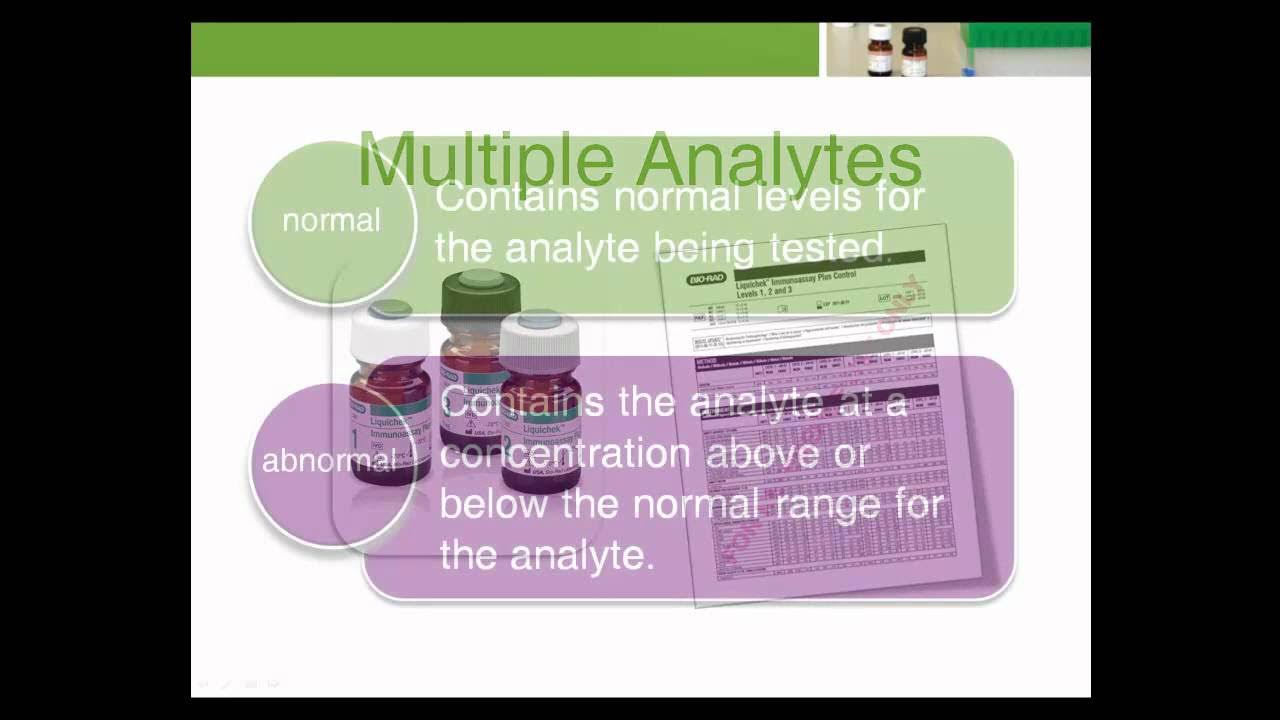Chapter 3 Levey-Jennings Charts & Westgard Rules
Summary
TLDRChapter 3 introduces Levey-Jennings Charts and Westgard Rules for quality control in laboratories. It explains how to calculate decision limits using standard deviation and illustrates their application on control charts. The script clarifies that only 0.3% of QC values should fall outside ±3s limits, indicating significant errors. It warns against prematurely invalidating patient results due to a single value outside ±2s limits. The importance of documenting QC results through logs and charts is emphasized, along with the detection of systematic and random errors. Westgard's rules for evaluating analytical run quality are outlined, providing a statistical basis for quality control in medical laboratories.
Takeaways
- 📊 Levey-Jennings (L-J) charts are used for plotting quality control (QC) values to monitor the performance of analytical processes.
- 📈 Standard deviation is key in calculating the decision limits (±1s, ±2s, and ±3s) for L-J charts, which help in assessing the control of test results.
- 🔍 A well-controlled analytical process will have approximately 68% of QC values within ±1s, 95.5% within ±2s, and 99.7% within ±3s of the mean.
- ⚠️ Values outside ±3s are indicative of significant error and should not be reported for patient results.
- 🚫 Laboratories should not dismiss an entire analytical run based on a single QC value outside ±2s but within ±3s, as this could lead to unnecessary repetition and delays.
- 📝 Maintaining a QC log is essential for documenting the assay of quality control materials and inspection of results, ensuring the quality of analytical runs.
- 🔍 Systematic errors in QC can manifest as trends or shifts in control values, suggesting issues like instrument deterioration or calibration inaccuracies.
- 🔎 Random errors are deviations from expected results, with acceptable random error defined by standard deviation; unacceptable error is any point outside the ±3s limits.
- 📚 Dr. James Westgard's rules provide a statistical framework for evaluating the quality of analytical runs, with six basic rules to identify random or systematic errors.
- 📝 The Westgard rules include 1-3s, 2-2s, R-4s, 3-1s, and 4-1s, each with specific criteria for identifying different types of errors in QC results.
Q & A
What is the primary purpose of a Levey-Jennings chart?
-The primary purpose of a Levey-Jennings chart is to graph successive quality control values for each test and level of control, allowing for the monitoring and evaluation of an analytical process's performance over time.
What are the decision limits used in Levey-Jennings charts?
-The decision limits used in Levey-Jennings charts are ±1s, ±2s, and ±3s from the mean, which represent one, two, and three standard deviations respectively.
What percentage of QC values are expected to fall within ±1 standard deviation when a process is in control?
-Approximately 68% of all QC values are expected to fall within ±1 standard deviation (1s) when the analytical process is in control.
How does the percentage of QC values within control limits change for ±2s and ±3s?
-About 95.5% of all QC values fall within ±2 standard deviations (2s), and approximately 99.7% of all QC values are within ±3 standard deviations (3s) when the process is in control.
What is the significance of a QC value falling outside the ±3s limits?
-Any value outside of ±3s is considered to be associated with a significant error condition, and patient results should not be reported.
Why might a laboratory incorrectly decide that patient specimens and QC values are invalid?
-Some laboratories might incorrectly decide that patient specimens and QC values are invalid if any quality control value is outside its ±2s limits, not realizing that approximately 4.5% of all valid QC values can fall between ±2 and ±3 standard deviation limits.
What is the importance of maintaining a QC Log in a laboratory?
-Maintaining a QC Log is important for documenting that quality control materials are assayed and that the quality control results have been inspected to assure the quality of the analytical run.
What are the two types of errors that can be identified through the analysis of QC results?
-The two types of errors that can be identified through the analysis of QC results are systematic error, which is evidenced by a change in the mean of the control values, and random error, which is any deviation away from the expected result.
What does a trend in control values indicate about the test system?
-A trend in control values indicates a gradual loss of reliability in the test system, which is usually subtle and may be caused by factors such as deterioration of the instrument light source or gradual accumulation of debris.
What is the difference between a trend and a shift in QC data?
-A trend represents a gradual change in the mean of the control values, while a shift indicates an abrupt and dramatic positive or negative change in test system performance.
What are the six basic rules in the Westgard scheme for evaluating the quality of analytical runs?
-The six basic rules in the Westgard scheme are 1-3s, 2-2s, R-4s, 10x, 4-1s, and 3-1s rules, which are used individually or in combination to evaluate the quality of analytical runs.
Outlines

This section is available to paid users only. Please upgrade to access this part.
Upgrade NowMindmap

This section is available to paid users only. Please upgrade to access this part.
Upgrade NowKeywords

This section is available to paid users only. Please upgrade to access this part.
Upgrade NowHighlights

This section is available to paid users only. Please upgrade to access this part.
Upgrade NowTranscripts

This section is available to paid users only. Please upgrade to access this part.
Upgrade NowBrowse More Related Video
5.0 / 5 (0 votes)





